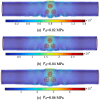Numerical simulation study on opening blood-brain barrier by ultrasonic cavitation
- PMID: 39098097
- PMCID: PMC11345312
- DOI: 10.1016/j.ultsonch.2024.107005
Numerical simulation study on opening blood-brain barrier by ultrasonic cavitation
Abstract
Experimental studies have shown that ultrasonic cavitation can reversibly open the blood-brain barrier (BBB) to assist drug delivery. Nevertheless, the majority of the present study focused on experimental aspects of BBB opening. In this study, we developed a three-bubble-liquid-solid model to investigate the dynamic behavior of multiple bubbles within the blood vessels, and elucidate the physical mechanism of drug molecules through endothelial cells under ultrasonic cavitation excitation. The results showed that the large bubbles have a significant inhibitory effect on the movement of small bubbles, and the vibration morphology of intravascular microbubbles was affected by the acoustic parameters, microbubble size, and the distance between the microbubbles. The ultrasonic cavitation can significantly enhance the unidirectional flux of drug molecules, and the unidirectional flux growth rate of the wall can reach more than 5 %. Microjets and shock waves emitted from microbubbles generate different stress distribution patterns on the vascular wall, which in turn affects the pore size of the vessel wall and the permeability of drug molecules. The vibration morphology of microbubbles is related to the concentration, arrangement and scale of microbubbles, and the drug permeation impact can be enhanced by optimizing bubble size and acoustic parameters. The results offer an extensive depiction of the factors influencing the blood-brain barrier opening through ultrasonic cavitation, and the model may provide a potential technique to actively regulate the penetration capacity of drugs through endothelial layer of the neurovascular system by regulating BBB opening.
Keywords: Blood–brain barrier; Drug delivery; Finite element method (FEM); Multiple bubbles.
Copyright © 2024 The Author(s). Published by Elsevier B.V. All rights reserved.
Conflict of interest statement
Declaration of competing interest The authors declare that they have no known competing financial interests or personal relationships that could have appeared to influence the work reported in this paper.
Figures























References
-
- Margulis M.A. Sonoluminescence and sonochemical reactions in cavitation fields. A review. Ultrasonics. 1985;23(4):157–169. doi: 10.1016/0041-624X(85)90024-1. - DOI
-
- Liu W., Li N., Weng C., et al. Bubble dynamics and pressure field characteristics of underwater detonation gas jet generated by a detonation tube. Phys. Fluids. 2021;33(2) doi: 10.1063/5.0029729. - DOI
-
- Favvas E.P., Kyzas G.Z., Efthimiadou E.K., et al. Bulk nanobubbles, generation methods and potential applications. Curr. Opin. Colloid. Interface Sci. 2021;54 doi: 10.1016/j.cocis.2021.101455. - DOI
MeSH terms
LinkOut - more resources
Full Text Sources

